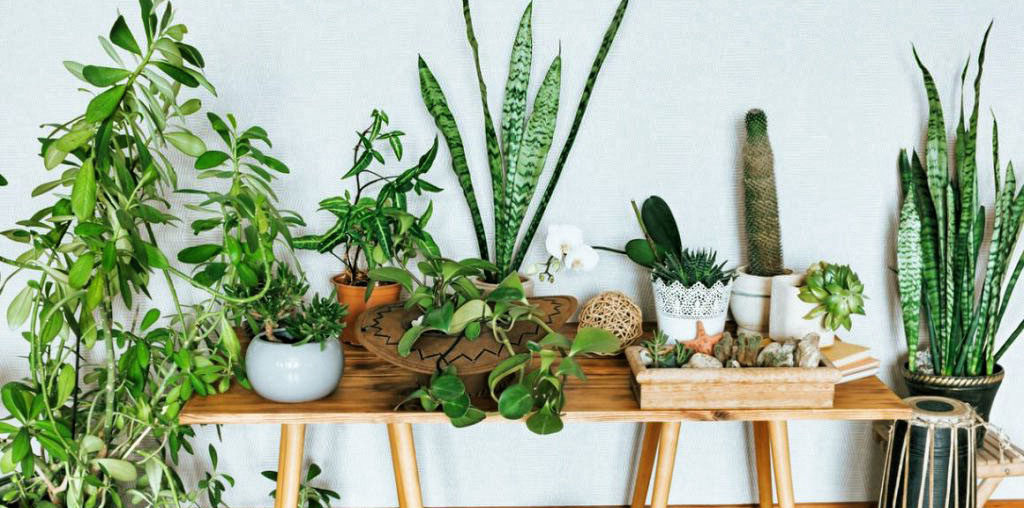To make your indoor plants breathe
A plant lives … and it breathes through its leaves. It is therefore essential that these are not dust traps.
The best method consists of washing the foliage regularly with a sponge soaked in lukewarm water. Rinse thoroughly, always with lukewarm water, until it is clear.
For plants with hairy foliage, use a small, soft brush, like the ones for styling babies.
Watch out for drafts! On the pretext that they must breathe, do not subject your plants to drafts, hot or cold. If you can open your windows wide in the summer, leave them ajar in the winter, or move the plants if possible.
Read also: How to properly ventilate your indoor plants?
To be beautiful …
If you’re freakish enough to want plants that shine and glow like brass, don’t overdo it.
After cleaning the foliage well, spray a commercial “polish” on it (some products have an insecticidal action). But please do not clog the pores of the foliage by brushing it with beer or milk.
For the intensity of the colored leaves, add a little charcoal to the compost.
Water reservoirs
When you know how to use them, they are very practical … but alas! they are also, most often, a source of trouble … for your plants! Many plants grow poorly there: they turn yellow, and lose leaf after leaf … The cause? You water too often and the soil does not have time to dry out between waterings, which is imperative. The soggy compost turns into swamp, and the plants, whose roots are asphyxiated, die more or less quickly.
To use these water reservoirs properly : the first three months following their installation in the tank, avoid watering from the reserve, to give the plants time to get used to it. Only fill this reserve if you have to be absent. After this quarter, you can ‘use it, filling it only two-thirds and especially letting the soil dry between two water supplies.
How to bathe a houseplant?
Drinking – which has nothing to do with a basin! is a spray of water, in a fine mist, on the foliage of houseplants. Its goal: to reduce the dryness of the ambient air.
Use a small sprayer and spray lukewarm water on the leaves … paying attention to furniture and the floor.
- A variant of drenching: a soft sponge, soaked in lukewarm water, is passed with the greatest delicacy over the leaves, to moisten them and also to clean them.
- Avoid drenching on species with sensitive or hairy foliage (in our hit parade, for each plant featured, we indicate in the “watering” section when this drenching is not recommended).
Read also: Indispensable tools for the indoor gardener
What light for your indoor plants?
Another important factor is light. It is better if it is natural, but you can compensate with special lamps, which are unfortunately quite expensive. A plant that lacks light “cries out in dismay”, withering, that is to say, desperately stretching its stems towards the nearest light source. It turns pale, while the colored species (croton, calathea, begonia rex, etc.) turn green with rage and lose all their beautiful colors and beautiful variegations,
The Ideal Exhibition? A window to the north or east. Beware, in fact, of the sun which burns most indoor plants, and burns them all when it is not sieved by any curtain (the glass is magnifying …).
Artificial lighting? It is very valid, but do not use any lamp that might burn the foliage of your plants. Invest in special lamps for vegetation.
Read also: How to properly light your indoor plants?
How to guard them?
Climbing plants, when they like, can become cumbersome. In addition, their flexible rods must be staked under penalty of crawling on your carpet.
- The classic tutor: in green plastic, in bamboo … Arrange it so that it is as little visible as possible.
- The Mossy Guardian: it is a piece of wire mesh 20 cm wide and the same length as the plant, which you will roll like a cigarette. Inside the fence, put some very damp foam (soak it an hour before), then roll and close the stake, Maintain with wire or a plastic tie.
- Then plant the tutor, and hide the mesh with a new layer of foam. Finally, attach the plant to its mossy stake. It is a process especially recommended for philodendrons, because their aerial roots pump the water contained in the moss (moisten it often).
- The lacquered oar : it is a tree branch, a ream of peas … Spray it on, in white or green, and use it as a tutor, by making the stems climb along of various branches and twigs. Guaranteed effect … and unusual!
How to ensure constant freshness for your indoor plants?
Many species hate central heating. For example, some palm trees, such as kentia, do not tolerate underfloor heating: they wither and die before having emitted a single palm. The same goes for ferns, which constantly require a humid environment to grow normally. A sudden drought, and their fronds crumble. To avoid all these inconveniences, here are some tips that will ensure your green plants a beneficial and constant freshness.
- Always group your plants, as they are much better off. Put them, for example, in a large bin. At the bottom of it, make a layer, at least 5 cm, of gravels or balls of expanded clay. Place the pots side by side and water them. Moisten the gravel bed as well, but the water should not cover it. Your plants are thus in a humid atmosphere, which they appreciate above all because it reminds them of the tropical undergrowth of their “childhood”.
- Same process for planters and plant pots : place the plants on a brick, on shards, gravel … and surround the pots with sphagnum, which you will often moisten. The plants will live in a cool climate, but beware! no swamp: water should never stagnate under the pot, so that the air can circulate inside the root ball.
- For your philodendrons and other species with aerial roots : hang small drinkers for birds, glass tubes (for test tubes), mini-bottles on the stake, and let the aerial roots bathe in them permanently.
- The material … of freshness: Small watering can, in plastic or brass, with a capacity of 2 L. Sprayer, also in plastic, brass or copper, with a variable capacity of 1/2 to 1 L. Electric humidifier, to reduce drought atmospheric.
Read also: Indoor plants: their natural water reservoirs
How to properly feed your green plants?
In addition to the repotting previously explained, and which allows a supply of new soil, you must regularly feed and fertilize your potted plants. Four formulas are at your disposal.
- Soluble fertilizer, powder and liquid, to be diluted in the irrigation water. This is our favorite.
- Powder fertilizer, to be spread with a teaspoon on the root ball.
- Foliar fertilizer; it is applied as a spray on the foliage and is quickly assimilated by the plant; it is carried by the sap to the roots. It is effective, but must be handled with caution, because it is too active and risks more or less serious damage to the foliage.
- Fertilizer stick: it is much slower in action, but continuous and therefore less dangerous.
Warning: In all cases, never add fertilizer to a dry root ball. Always water beforehand, and better, soak the root ball in the case of heather earth species, a material harder to moisten. By applying fertilizer without watering first, you almost certainly risk burning the roots of your plants. Moisten even if you are using soluble fertilizer.
Read also :







